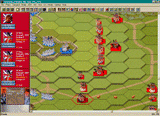 With the recent exodus of talented wargame
designers from Talonsoft, grognards can read the writing on the wall—it’s going
to get harder and harder to find hardcore wargames published by big game companies. In a lot of ways, the PC wargaming market is
developing in much the same way board wargaming has, where large companies like the
Hasbro-owned Avalon Hill are producing “lite” wargames, while smaller companies
(like GMT or The Gamers) produce serious wargames available only by mail order. Resign yourself to this: you’re not going to
see as many wargames on your local store shelves, but you’ll still be able to find
excellent wargames produced by small, independent companies. A good example of this trend
is Campaign 1776, a top-notch wargame designed by ex-Talonsoft employee John Tiller and
published by HPS Simulations. With the recent exodus of talented wargame
designers from Talonsoft, grognards can read the writing on the wall—it’s going
to get harder and harder to find hardcore wargames published by big game companies. In a lot of ways, the PC wargaming market is
developing in much the same way board wargaming has, where large companies like the
Hasbro-owned Avalon Hill are producing “lite” wargames, while smaller companies
(like GMT or The Gamers) produce serious wargames available only by mail order. Resign yourself to this: you’re not going to
see as many wargames on your local store shelves, but you’ll still be able to find
excellent wargames produced by small, independent companies. A good example of this trend
is Campaign 1776, a top-notch wargame designed by ex-Talonsoft employee John Tiller and
published by HPS Simulations.
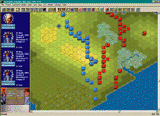 Campaign 1776 allows you to
refight about 20 battles from the American Revolutionary War, as well as about 30
hypothetical scenarios. Most every major battle of the revolution has made it into the
game: Saratoga, Brandywine Creek, Monmouth, Cowpens, Guilford Court House, Bunker
Hill—and if that’s not enough the game also includes a scenario and campaign
editor. In addition to the stand alone scenarios, you can fight four different campaigns:
Gates vs. Burgoyne, Washington vs. Howe, Greene vs. Cornwallis Burgoyne and a monster
campaign that ties them all together. The battles themselves are fought out at the
tactical level. Hexes are 125 meters across, units are companies (usually 30-50 men),
troops, and individual artillery pieces. Each turn represents five minutes of real
time. The game is your basic turn-based wargame, with each turn made up of an Igo-Ugo
sequence of movement, defensive fire, offensive fire and melee, which is then repeated by
the second player. If this all sounds pretty familiar, it is: at the tactical level 1776
plays a lot like the great Talonsoft Battleground games. Which, of course, John Tiller
played a large role in designing. Campaign 1776 allows you to
refight about 20 battles from the American Revolutionary War, as well as about 30
hypothetical scenarios. Most every major battle of the revolution has made it into the
game: Saratoga, Brandywine Creek, Monmouth, Cowpens, Guilford Court House, Bunker
Hill—and if that’s not enough the game also includes a scenario and campaign
editor. In addition to the stand alone scenarios, you can fight four different campaigns:
Gates vs. Burgoyne, Washington vs. Howe, Greene vs. Cornwallis Burgoyne and a monster
campaign that ties them all together. The battles themselves are fought out at the
tactical level. Hexes are 125 meters across, units are companies (usually 30-50 men),
troops, and individual artillery pieces. Each turn represents five minutes of real
time. The game is your basic turn-based wargame, with each turn made up of an Igo-Ugo
sequence of movement, defensive fire, offensive fire and melee, which is then repeated by
the second player. If this all sounds pretty familiar, it is: at the tactical level 1776
plays a lot like the great Talonsoft Battleground games. Which, of course, John Tiller
played a large role in designing.
In fact, the game’s interface (which is very well-implemented) will remind you
immediately of the BG series. The familiar toolbar runs across the top of the
screen, drop-down menus are available for more arcane commands and in-depth information,
and the trademark “next phase” box with the “turn # of #” is still
there.
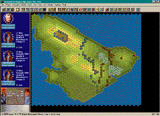 There are, of course, some
differences, mostly because this is an American Revolutionary War game, and the tactics
you’ll have to use to succeed are a little different than those of a Napoleonic or
Civil War game. Revolutionary War battles are infantry battles. Almost all cavalry
is really mounted infantry, so don’t expect any Eylau-type charges, and most
artillery is limited and light, so don’t expect any grand batteries of
twelve-pounders. Nope, this is down-and-dirty grunt war in the woods. This means keeping a
close eye on your unit’s quality ratings, the amount of fire they’ve taken and
time they’ve spent in the line, their command status, their facing, and their
formation (extended formation is a godsend for American troops). Most of the fire is
close-up musket volley, though some rifle units will show up on the American side (and an
optional rule makes them very nasty). As in Barry Lyndon, it pays to hold your fire
until an opponent is right on top of you. A unit’s first volley is especially deadly,
and you don’t want to waste it on a distant target. Morale is crucial: units break
more often than they evaporate, and it’s not unusual to see militia units bugout at
the first hint of combat. All of this attention to detail makes for a game that captures
the feel of American Revolutionary War combat superbly; gameplay is tense, dramatic, and a
whole lot of fun. There are, of course, some
differences, mostly because this is an American Revolutionary War game, and the tactics
you’ll have to use to succeed are a little different than those of a Napoleonic or
Civil War game. Revolutionary War battles are infantry battles. Almost all cavalry
is really mounted infantry, so don’t expect any Eylau-type charges, and most
artillery is limited and light, so don’t expect any grand batteries of
twelve-pounders. Nope, this is down-and-dirty grunt war in the woods. This means keeping a
close eye on your unit’s quality ratings, the amount of fire they’ve taken and
time they’ve spent in the line, their command status, their facing, and their
formation (extended formation is a godsend for American troops). Most of the fire is
close-up musket volley, though some rifle units will show up on the American side (and an
optional rule makes them very nasty). As in Barry Lyndon, it pays to hold your fire
until an opponent is right on top of you. A unit’s first volley is especially deadly,
and you don’t want to waste it on a distant target. Morale is crucial: units break
more often than they evaporate, and it’s not unusual to see militia units bugout at
the first hint of combat. All of this attention to detail makes for a game that captures
the feel of American Revolutionary War combat superbly; gameplay is tense, dramatic, and a
whole lot of fun.
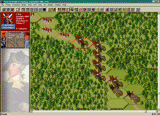 1776’s campaign game is very well-implemented. When it begins,
you’ll be given a briefing on the general situation, then presented with a series of
possible operational decisions. The tactical battles you’ll fight afterwards will
depend upon this choice, as well as other operational choices you’ll make between
battles. If you're pressed for time, 1776 includes a feature that allows the computer to
fight some battles for you; if you think you’ve got the enemy outmaneuvered and
outclassed, you can let the computer generate the most likely outcome and go on to more
interesting battles. 1776’s campaign game is very well-implemented. When it begins,
you’ll be given a briefing on the general situation, then presented with a series of
possible operational decisions. The tactical battles you’ll fight afterwards will
depend upon this choice, as well as other operational choices you’ll make between
battles. If you're pressed for time, 1776 includes a feature that allows the computer to
fight some battles for you; if you think you’ve got the enemy outmaneuvered and
outclassed, you can let the computer generate the most likely outcome and go on to more
interesting battles.
It helps that the game’s documentation is first-rate as well. Though our gold master
didn’t come with a printed manual, the online printout of what we suppose will be
manual gives clear and thorough explanations of combat, leadership and morale effects. The
Bunker Hill scenario makes for a quick little tutorial, and the designer notes are
informative, helpful, and well-written.
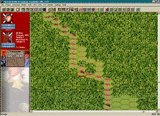 There are a few things about the
game that aren’t luxury-class, though, and the most noticeable of these is the
game’s look. 1776's graphics are dated even by wargame standards. Even though I know
that wargamers are supposed to rise above such mundane concerns, the game just isn’t
as pretty as it should have been. One of the big selling points of the Revolutionary War
is the graphic oomph of ragged Continentals and militia lining up against splendid
lobsterbacks, and it just doesn’t come across in the game’s 3D views. Even
worse, this can sometimes be a gameplay problem; it can be very difficult to distinguish
facing when two or more units are in a hex—especially since the facing indicator in
the unit info box is sometimes inaccurate. If
you care about graphics, you’ll be disappointed by this game’s old school look.
On the other hand, the game’s sound is superb, with period music by Tom Hook that
even my kids liked. There are a few things about the
game that aren’t luxury-class, though, and the most noticeable of these is the
game’s look. 1776's graphics are dated even by wargame standards. Even though I know
that wargamers are supposed to rise above such mundane concerns, the game just isn’t
as pretty as it should have been. One of the big selling points of the Revolutionary War
is the graphic oomph of ragged Continentals and militia lining up against splendid
lobsterbacks, and it just doesn’t come across in the game’s 3D views. Even
worse, this can sometimes be a gameplay problem; it can be very difficult to distinguish
facing when two or more units are in a hex—especially since the facing indicator in
the unit info box is sometimes inaccurate. If
you care about graphics, you’ll be disappointed by this game’s old school look.
On the other hand, the game’s sound is superb, with period music by Tom Hook that
even my kids liked.
A few more little things that could
be sharpened up: if you kill off an enemy combat unit and only a leader remains in the
hex, you can’t move through it. I doubt even the most inspirational of generals could
hold up 100 determined grenadiers, but there you have it. And one last gripe: scroll bars.
After playing Napoleon: 1813 for hours, I was determined never to play another game with
scroll bars. Lo and behold, Campaign 1776 uses them. I’m playing anyway, but I’m
not happy about them.
Multiplayer is well-supported, with
the de rigeur PBEM, Modem, LAN, and Internet play available.
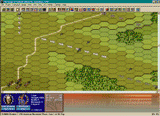 For grognards, this game is a
no-brainer; there aren’t that many Revolutionary War games out there—I
can’t think of any offhand—and Campaign 1776 does a primo job of modeling ARW
battles. Even with subpar graphics, it’s a stellar game. But you can’t get it at you local Electronics
Boutique; you’ll have to order it direct from HPS at www.hpssims.com. It will officially be released on
March 1st, though you can pre-order now, and at $39.95, it’s a steal. If
you’re a wargamer, bookmark their site; with release of Smolensk ’41 and
Campaign 1776 in the last few months, HPS has become a wargame company to be reckoned
with. For grognards, this game is a
no-brainer; there aren’t that many Revolutionary War games out there—I
can’t think of any offhand—and Campaign 1776 does a primo job of modeling ARW
battles. Even with subpar graphics, it’s a stellar game. But you can’t get it at you local Electronics
Boutique; you’ll have to order it direct from HPS at www.hpssims.com. It will officially be released on
March 1st, though you can pre-order now, and at $39.95, it’s a steal. If
you’re a wargamer, bookmark their site; with release of Smolensk ’41 and
Campaign 1776 in the last few months, HPS has become a wargame company to be reckoned
with.
--Rick
Fehrenbacher |
